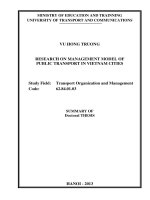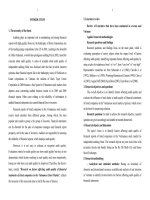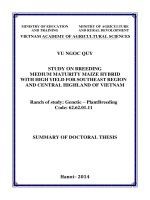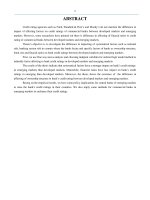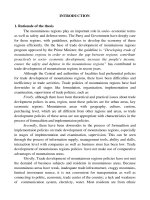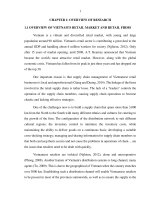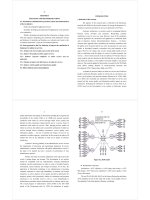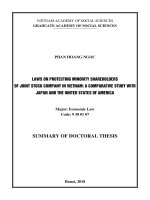Summary of doctoral thesis: Research on the macro fungi Myxomycota, Ascomycota, Basidiomycota in Ngoc Linh mountain, Quang Nam province
Bạn đang xem bản rút gọn của tài liệu. Xem và tải ngay bản đầy đủ của tài liệu tại đây (502.18 KB, 27 trang )
MINISTRY OF EDUCATION AND
VIETNAM ACADEMY
TRAINING
OF SCIENCE AND TECHNOLOGY
GRADUATE UNIVERSITY SCIENCE AND TECHNOLOGY
----------------------------
TRAN THI PHU
RESEARCH ON THE MACRO FUNGI
MYXOMYCOTA, ASCOMYCOTA, BASIDIOMYCOTA
IN NGOC LINH MOUNTAIN, QUANG NAM PROVINCE
Major: Botany
Code: 9.42.01.11
SUMMARY OF DOCTORAL THESIS
HANOI – 2018
The thesis is completed at: Graduate University of Science and Technology Vietnam Academy of Science and Technology
Supervisors:
1. Prof. Dr. Sc. TRINH TAM KIET
2. Assoc. Prof. Dr. NGUYEN KHAC KHOI
Reviewer 1:
Reviewer 2:
Reviewer 3:
The doctoral thesis will be defended at the Evaluation Committee of Graduate
University of Science and Technology, Vietnam Academy of Science and
Technology. Time: Date…. month …. 2018
This thesis can be found at:
- The library of Graduate University of Science and Technology;
- National Library of Vietnam
1
Introduction
1. Rationale
The kingdom fungi contains heterogeneous organisms, with over 100,000
described species (Kirk P.M, 2008), however, as expected Hawksworth (2001) the
number of fungal species can be up to 1,500,000 species. Fungi are very
meaningful in practice, many species make food: Volvariella, Auricularia,
Pleurotus; medicinal products: Ganoderma luc, Trametes versicolor, Cordyceps
etc applied in pharmaceutical technology. In science, many species (Lentinus
tigrinus, Schizophyllum commune) is the subject of studies on physiology,
biochemistry and genetics. Besides, there are many species of fungi that harm
plants and animals, some poisonous fungus cause coma and death for human.
Researches on macrofungi in Central Vietnam have been mentioned such as
Patouillard, N. (1923, 1928), Joly P. (1968), Ngo A. (2003), Dörfelt, H., Trinh
T.K, Berg, A. (2004) etc, However, fungus research is still limited, so collecting
and classifying fungus in the Central and Highlands has significant scientific and
practical significance.
In Ngoc Linh mountain, Quang Nam province, not has studied the macro
fungi. Therefore, "Research on the macro fungi Myxomycota, Ascomycota,
Basidiomycota in Ngoc Linh mountain, Quang Nam province" is a necessary to
identify and contribute to the protection of the diversity of species composition,
the rational use of resources, the protection of rare genetic resources for the
Vietnam mushroom complex.
2. The Objective of the dissertation
- Make a checklist of the macro fungi species;
- Evaluate diversity of species composition, resource value of macro fungi;
- Created a checklist for classification of indentified species of Myxomycota,
Ascomycota, Basidiomycota in Ngoc Linh mountain, Quang Nam province.
3. Scientific and practical significance
For the first time, the research provides a checklist of the macro fungi species,
evaluate of diversity of species composition, resource value of the macro fungi,
2
constructs identification key, and describes the new species of fungus recorded for
the genera and the valuable species macro fungi of the Myxomycota, Ascomycota,
Basidiomycota in Ngoc Linh mountain, Quang Nam province, Vietnam.
4. Layout of the dissertation
The dissertation consists of 150 pages, 65 images, and 12 tables.
Introduction (2 pages), Chapter 1: Literature review (16 pages), Chapter 2:
Object, content, research methods and natural, social conditions in Ngoc Linh
mountain, Quang Nam province (13 pages), Chapter 3: Results and discussion
(106 pages), Conclusions and recommendations (3 pages), References (9 pages),
List of author’s publications.
Chapter 1. Literature review
1.1. Some main mushroom systems
Mushroom systems of Gaümann (1964); Kreisel (1969); Ainsworth, Bisby
(1971); Kirk P.M. “Dictionary of the fungi” (2008); Trinh T.K. (2014) “Check-list
macro fungi in Viet Nam”
1.2. Macro fungi research in Myxomycota, Ascomycota, Basidiomycota in
the world
Before the XIX century, in the world Théophraste and Aristote studied
Tuberaceae and Agaricaceae. Linnaeus with “Species plantarum”, some species of
fungus have been mentioned. De Bary A., (1887) in London “Comparative
morphology and biology of the fungi, Mycetozoa and Bacteria”, compared the
characteristics of fungi, animals and bacteria.
The XX century, in New Zealand, Cunningham G.H., (1965) announced 550
species the Polypore. Corner E.J.H., research “Ad Polyporaceas II, III, IV”
described of morphology, key to species of the Polypocre. Donk M.A., (1967)
described, identificated key to species of the Polypocre in Europe. In 1970, Teng
S.C., described 2400 species, 601 genera, 5 classes. Rolf Singer, (1986) with “The
Agaricales in modern taxonomy”, described morphology, structure and spore the
230 genera, 17 families, the Agaricales. Zhao Ji-Ding, (1989) in “The
Ganodermataceae in China”, described hyphae, spores and identification key to
3
Ganoderma with 64 species, Amauroderma with 20 species, Haddowia and
Humphreya with 2 species. The theme "Pilze der Schweiz" for 25 years of
Breitenbach. J. and Kraenzlin F. generalized the Ascomycota and Basidiomycota
of Switzerland.
The XXI century: Mao Xiaolan (2000) published “The Macro fungi in China”,
described morphology, structure hyphae, spores. Heikki K. described and
identificated key to 139 the Polypore in Russia. Zmitrovich I.V (2012), found
identification key to 63 species, genera Trametes. Dörfelt, Heinrich, (2014) with
“Morphologie der Großpilze” described morphology macro fungi: surface,
hymenophore, skeletal hyphe, hyphe, spores, hole, the stratification of the tube
etc. In Brazil Gomes-Silva A.C. (2015), analysed morphology and molecular of 20
species, the genera Amauroderma, 6 new species for science. In 2017, Ginns J.
with “Polypores of British Columbia” described the morphological characteristics
of 200 species the polypore: surface, hyphe, hymenophore, spores etc and
construct identification key.
1.3. Macro fungi research in Myxomycota, Ascomycota, Basidiomycota in
Vietnam
Macro fungi research in Vietnam: Patouillard N.M. with 3 volumes of
mushroom publications 1876-1924, described 235 species have been recognized
44 species for Vietnam. Joly P. (1968), in Lang-Bian, described 20 species, genus,
Xylaria. In 1986, Parmasto E. summarized 310 species in the "Preliminary
Catalog of Fungi Aphyllophorales and Polyporaeae s.str. Vietnam".
Research on mushrooms in the North with typical works: Trinh T.K. (1981)
published "Macro fungi of Viet Nam", describing 116 species. In 1991, Phan H.D
announced 56 species. A checklist 837 species of macrofungi of Vietnam
“Preliminary checklist of macrofungi of Vietnam” by Trinh T.K. in 1996. Trinh
T.K and Trinh T.B. (2008) identified checklist 210 species of medicinal fungus.
In the Central region, Ngo A. (2003) identified in Hue 4 classes, 28 orders, 55
families, 134 genera, 346 species, new record: 1 family the Gomphidiaceae, 7
genera, 39 species. Ngo A., and Nguyen T.K.C., (2013) identified 162 species, 63
4
genera, 30 families, 18 orders, 2 divisions the Ascomycota, Basidiomycota, 21
species new record. Ngo A., and Phan T.A.L. (2017) identified 305 species, 92
genera, 43 families, 23 orders, 3 classes, 3 divisions the Myxomycota,
Ascomycota, Basidiomycota, 42 new record species.
In highlands: Le B.D. (2001), with "Highlands macro fungi system" introduced
basic knowledge, methods and descriptions of 300 species of mushrooms. Nguyen
P.D.N. (2013) recorded three new species the Ganodermataceae. Pham T.H.G.
recorded 51 species, 23 families, 9 orders, in Chu Yang Sin National Park. In
2016, Le B.D studied genus Coprinus in Lam Vien, including 6 species. Nguyen
P.D.N (2017) described 6 species, genus Boletus, recorded two new species.
In the South Vietnam, Le X.T., with "Development of mushroom production
on the basis of investigating mushroom museum in Cat Tien National Park" from
2004-2009 identified 370 species, 128 genera, 45 families, 22 orders. Le X.T.
(2010) published "Fungi in technology and environmental transformation"
describing the morphology, microscopic structure of Ganodermataceae. Cat Tien
in 2013. Tran T.M.H. (2017) with “Myxomycetes of Vietnam”, described of the
book 56 species of Myxomycetes for Vietnam.
Special, in 3 book of "Macro fungi of Vietnam", Trinh T.K. has showed a
macro fungi system, character analysis, methods of collection, storage,
classification, biodiversity, ecological analysis, life style etc.., described the fungal
species of the 4 divisions Myxomycota, Glomeromycota, Ascomycota and
Basidiomycota with about 1821 species, over 1,000 illustrations.
Currently, in Ngoc Linh mountain, Quang Nam province, no has studied the
macro fungi, so researching the macro fungi in Ngoc Linh mountain, Quang Nam
province is a very important and necessary task.
Chapter 2. Object content, research methods and natural, conditions in
Ngoc Linh mountain, Quang Nam province
2.1. Object, research location
Macro fungi of the 3 divisions Myxomycota, Ascomycota, Bosidiomycota in
Ngoc Linh mountain, Quang Nam province; 7 communes in Nam Tra My district.
5
2.2. Research content
Study on morphology and structure of the microscope; Develop a list of
species composition; Diverse research; Analysis of resource value; Construction
of identification keys; Describe some new species, valuable species.
2.3. Research methods
Methods of collection, processing, analysis, and classification by Hanns
Kreisel (1975), Singer R. (1986), Zhao J.D. (1989), Gilbertson R.L. & Ryvarden
L. (1993), Trinh T.K. (2011-2013).
List of macro fungi sorted by Kirk P.M. (2008), Trinh T.K. (2014). Diversity
of living methods, geographic factors, resource values: inheritance of existing
data, folk surveys, traditional experience.
2.4. Natural conditions in Ngoc Linh mountain, Quang Nam province
Geographical location: 7 communes in Nam Tra My district, Quang Nam
province
Topographic features: slope 25°, height 1,600-1,800 m, mountain straight strip.
Land features: thin earth layer, carpet layer, humus 30-50 cm.
Characteristics of rivers, hydrography: upstream of Tranh river. The flow of
rivers and streams varies with the season, the flow of the flood season is twice the
dry season.
Climate features: North-Southwest monsoon, tropical climate, subtropical:
high rainfall and humidity, evaporation and low temperatures.
Natural forest characteristics: complex, strong separates, rugged mountains,
narrow valleys, rich populations of plants. In lowland, tropical evergreen moist
forest type, dense, multi-storey wide leaves. The higher the type of forest subtropical evergreen closed forest, bamboo. Forests also have many specialties.
Many animals (wild boar, goose, gill, squirrel, etc).
Chapter 3. Results and Discussion
3.1. Morphological and microscopic feature of Mycomycota, Ascomycota,
Basidiomycota.
6
3.1.1.
Morphological
characteristics
of
Mycomycota,
Ascomycota,
Basidiomycota.
Fruiting body: the Myxogastria: globose (Fuligo septic), a pelviform,
(Physarum pezizoideum), long cylindriform (Stemonitis longa) etc. The Ascocarp:
split 2 to 3 lobes (Hypocrea peltata), substrale push close (Annulohypoxylon
annulatum), spherical (Daldinia concentrica), cylindrical (Xylaria longipes) etc.
The Basidiocarp: dermatoid (Stereum rugosum), wood stratiform (Perenniporia
martia), unguliform (Phellinus chrysoloma), pulvinoid (Ganoderma phillipii),
lumpsform (Phellinus pomaceus), high foundation (Phellinus robiniae), fanform
(Microporus affinis), Shellfishform (Amauroderma scopulosum), shallow hopper
form (Panus conchatus), tuberous form (Scleroderma verrucosum), actimiform
(Geastrum fimbriatum), egg-shaped (Bovista pila), umbraculiform (Amanita aff.
xanthogala), cone form (Leucocoprinus birnbaumii), round umbraculiform
(Russula emetica), campaniforma (Marasmius siccus), retiform (Phallus
multicolor) etc.
Fruiting color: The Myxomycota: a sallow (Fuligo septic), blue (Physarum
pezizoideum), green gold (Physarum viride) etc. Ascomycota: light pink
(Hypocrea peltata), blue black (Annulohypoxylon annulatum), red (Cookenia
tricholoma) etc. Basidiomycota: black (Nigrofomes melanoporus), pale brown
(Ganoderma lobatum), reddish brown (Fomitopsis pinicola), Orange (Pycnoporus
sanguineus), yellow (Inocybe asterospora), white (Coprinellus disseminates),
purple (Scleroderma citrinum), colorful (Trametes versicolor) etc.
Fruiting size: Myxomycota: small 2-4 mm Arcyria incarnata, great 5-20 mm
Stemonitis longa,. Ascomycota: small 2-4 mm Annulohypoxylon annulatum,
medium 4-10 mm Pithya cupressina, more than 1 cm Xylaria longipes.
Basidiomycota: small 1-3 cm (Amauroderma), medium 3-20 cm (Fomitopsis,
Trametes), larger than 10 cm (G.australe, N.melasola)
Fruiting surface: smooth (G.sessile), smooth shine (G.fuvellum), smooth and
veined (Microporus xanthopus), concentric belt (G.australe), cracked bird's legs
(G.tornatum), rough hair (Trichaptum biforme), fine hair (Auricularia auricula-
7
judae), thorn hair (Hexagonia tenuis), fixed hair (Pholiota aurivella), scutellum
(Auricularia cornea), scutellum tiger dermatoid (Lentinus tigrinus) etc.
Hymenophor: plicate form, tubate form or serate form, lamenlan form.
Plicateform (Cymatoderma), flange, beak ridge (Auricularia mesenterica).
Tubateform: Hymenophor formed farion including a unistrale hyphe
(Ganoderma luteomarginatum), a bifarious hyphe (G.australe), multifarious hyphe
(Perenniporia martia), the fungus tabulate grow up next husband (Nigrofomes
melanoporus), centrical multifarious laminar tissue (G.applanatum). Tube
construction structure: structure to pycnoxytic (Phellinus, Nigrofomes), matter
tough lie in genus Trametes, colloid after drying farion keratose (Fomitopsis).
Some species in genus Aureoboletus, Boletus The Fungus tabulate grows steadily
into the tissue, just lying on the flat surface so it is easy to separate.
Hymenophor a lamenla form including: generative laminate (Volvariella),
concave laminate (Inocybe asterospora), bipartition laminate (Schizophyllum
commune), laminate reduced tendonform, carinateform (Anthracophyllum
archeri), rivulone laminate (Macrocybe giganteus), integration laminate concave
tendonform, rugose, free genera Agaricus, Pluteus, think laminate, close together,
a peripterous pedicel genus Lentinus
Fungus tissue: 2 layers of tissue a homochromatic with hymenophor the
Phellinus, 2 layers of tissue heterochromia the Ganoderma. Fungus tissue hyphae
trimitic, skleretiv hyphe (Phellinus, Ganoderma, Fomitopsis), matter tough,
durable lie in (Trametes), colloid the Auricularia, Tremella, after drying farion
keratose, tough cuticle Lentinus, genus Panus, monomitic hyphe parenchymal
tissue, slime, shrinkage, change at dry time, tendrer sarcoplasm fragile the genera
Russula. Fungus smell sarcoplasm: dried fish Ischnoderma sp, dried squid
Lentinula, fragrant sweet smell Pleurotus, Macrolepiota albuminosa, acinidity
malodous Chlorophyllum, bad-egg odouur Boletus, Aureoboletus. Fungus taste
sarcoplasm: sweet Macrolepiota albuminosa, before the bitter after the sweet
Ganoderma lucidum, salty taste G.subresinosum.
Spore in: color: white, black, pink, yellow, orange, brown, red, blue, purple.
8
Fungi stalk: stalt a atelomitic (Amauroderma guangxiense), stalt a no proofreaing or a dorsiferous (A.preussii), stalk a adnate (A.exile).
Stalk color: same color with basidiocarp, some stalk color with basidiocarp, eg
species Microporus affinis, yellow hooded black stalk.
Stalk surface: slippery stalk (Amauroderma), a cyclo brachiate, no bag
(Chlorophyllum hortense), have bag, not round (Volvariella volvacea), plumulata
(Lepiota
cristata),
squamule
(Leucocoprinus
birnbaumii),
firm
lignin
(Amauroderma), sarcoplasm (Agaricus, Lepiota), porous, hollow (Coprinus,
Russula).
Stalk body: cylinder (Amauroderma), bulge in the abdomen (Amanita aff.
xanthogala), rhizoid (Hymenopellis megalospora).
Stalk size: long (Amauroderma preussii), short (Ganoderma pfeifferi), to big
(G.tropicum, G.gibbosum), small (Microporus xanthopus).
3.1.2. Some microscopic characteristics of macro fungi of Mycomycota,
Ascomycota, Basidiomycota.
Hyphesystem:
generative
hyphe:
a
polycystid
horizontal
partition
(Cymatoderma), a key (Polyporus arcularius). Skleretiv hyphe (Phellinus), the
lignin (Ganoderma), skin substance (Stereum). Bindel hyphe: a thick membranous
share multiple branches, short, zigzag, no key, a noendoplasmic, size 1-6 µm.
Hymenium: the Myxomycota not hymenium, only agency spores to bring.
Ascus: Reproduction is usually at the bottom of ascocarpe, perithetium, or on
the ascocarpe a lamelliform, diskform, acetabuliform. They usually form a fence,
made up of ascus, paraphysa and periphysa.
Ascospores: Spores are decorated by folds in length Cookeina sulcipes,
vertical line (C.tricoloma), big drop of oil (Pithya) etc.
Basidie: Holobasidie (Hymenomyces, Gasteromycetes), obovoid (Ganoderma
lucidum), maceform (Pleurotus pulmonarius, Lentinula edodes), oval truncate
(Ganoderma capense), in a basidie have 4 sterigma or 2 sterigma.
Phragmobasidie there are 3 vertical membranes forming 4 cells or formed 3
horizontal baffles, forming 4 cells in succession. Size: Macro 43-53 x 4-5 µm
9
(Auricularia mesenterica), medium 15-30 x 5-10 µm (Macrocybe giganteus),
small 9-12 x 4-6 µm (Lentinus squarrosulus).
Basidispores: Spores a pelliculate a cylindrical form (Pleurotus), kidney shape
(Leucoagaricus aff. rubrotinctus), sclereform (Scleroderma), sclera globular
(Russula), elip (Lentinus tigrinus) etc, a thick membranous (Perenniporia), private
the Ganodermataceae two membrannaceous layers, obovoid (Amauroderma),
oval truncate (Ganoderma). Color: yellow (Ganoderma), yellow helvus (Serpula),
purple infuscate (Parasola), black (Coprinus).
3.2. Checklist of species of macro fungi in Ngoc Linh mountain, Quang Nam
province
3.2.1. Checklist of species of macro fungi in Ngoc Linh mountain, Quang Nam
province
1. Divisions MYXOMYCOTA
1. Classes Myxomycetes:
1. Physarales: Physaraceae: Fuligo septic; Physarum pezizoideum, P.viride.
2. Stemonitales: Stemonitaceae: Stemonitis longa.
3. Trichiales: Arcyriaceae: Arcyria denudate, A.incarnata.
2. Classis Ceratiomyxomycetes
4. Ceratiomyxales: Ceratiomyxaceae: Ceratiomyxa fruticulosa.
2. Divisions ASCOMYCOTA
3. Classes Sordariomycetes
5. Hypocreales: Hypocreaceae: Hypocrea peltata, H.rufa; Nectriaceae:
Nectria peziza.
6.
Xylariales:
Xylariaceae:
Annulohypoxylon
annulatum;
Daldinia
concentric, D.fissa; Xylaria longipes.
4. Classes Pezizomycetes
7. Pezizales: Pyronemataceae:
Sowerbyella rhenana; Sarcoscyphaceae:
Pithya cupressina; Cookeina sulcipes, C.tricholoma.
3. Divisions BASIDIOMYCOTA
5. Classes Tremellomycetes
10
8. Tremellales: Tremellaceae: Tremella fuciformis, T.mesenterica
6. Classis Dacrymycetes
9. Dacrymycetales: Dacrymycetaceae:
Dacrymyces chrysospermus,
D.stillatus; Dacryopinax spathularia; Calocera cornea.
7. Classes Agaricomycetes
10. Auriculariales: Auriculariaceae: Auricularia auricula-judae, A.cornea,
A.delicata, A.fuscosuccinea, A.mesenterica, A. nigricans.
11. Thelephorales: Thelephoraceae: Thelephora atrocitrina.
12. Cantharellales: Cantharellaceae: Cantharellus sp, C.wellingtonensis.
13. Hymenochaetales: Hymenochaetaceae: Trichaptum biforme; Inonotus
hispidus, Inonotus sp, I.tabacinus, I.rickii; Phellinus allardii, P.adamantinus,
P.chrysoloma,
P.gilvus,
P.hartigii,
P.igniarius,
P.pomaceus,
P.robiniae;
Phellinopsis conchata; Fomitiporia hippophaëicola, F.punctata; Phellinidium
ferrugineofuscum, P.lamaoense; Fuscoporia torulosa.
14. Polyporales: Meruliaceae: Cymatoderma caperatum, C. dendriticum, C.
elegans;
Rigidoporus
microporus;
Phlebia
tremellosa; Flavodon
flavus;
Ganodermataceae: Ganoderma adspersum, G. ahmadii, G. amboinense, G.
annulare, G. applanatum, G. australe, G. brownii, G. capense, G. cochlear, G.
dahlii, G. fulvellum, G. gibbosum, G. hainanense, G. lobatum, G. lucidum, G.
luteomarginatum, G. mirivelutinum, G. multipileum, G. orbiforme, G. oroflavum,
G. philippii, G. resinaceum, G. rotundatum, G. sessile, G. simaoense, G. sinense,
G. steyaertianum, G. subtornatum, G. testaceum, G. tornatum, G. tropicum, G.
triangulum, G. tsugae, G. ungulatum; Amauroderma auriscalpium, A. exile, A.
guangxiense, A. infundibuliforme, A. nigrum, A. praetervisum, A. preussii, A.
rude, A. rugosum, A. scopulosum, A. subresinosum, A. subrugosum, Amauroderma
sp; Haddowia longipes, Haddowia sp.; Humphreya coffeata; Fomitopsidaceae:
Antrodia
heteromorpha;
Neoantrodia
variiformis;
Fomitopsis
castanea,
F.pinicola; Daedalea dochmia; Ischnoderma sp.; Laetiporus gilbertsonii;
Niveoporofomes spraguei; Rhodofomes cajanderi, R. roseus; Polyporaceae:
Cerrena drummondii, C.unicolor, C.zonata; Coriolopsis gallica, C.suberosifusca;
11
Funalia caperata, F. sanguinaria; Daedaleopsis confragosa, D. tricolor;
Hexagonia apiaria, H. tenuis, H. variegata; Cellulariella acuta; Microporus
affinis, M. xanthopus; Nigrofomes melanoporus; Perenniporia fraxinea, P.
fraxinophila, P. martia, Perenniporia sp.; Pycnoporus cinnabarinus, P.
sanguineus; Earliella scabrosa; Trametes cingulata, T. cubensis, T. elegans, T.
gibbosa, T. hirsuta, T. meyenii, T. modesta, T. ochracea, T. orientalis, T. palisotii,
T. pubescens, T. robiniophila, T. suaveolens, T. strumosa, T. trogii, T. versicolor,
T. vernicipes, T. villosa; Leiotrametes lactinea; Trametopsis cervina; Tyromyces
chioneus; Aurantiporus fissilis; Polyporus arcularius, P. grammocephalus;
Neofavolus alveolaris; Cerioporus leptocephalus, C. meridionalis, C. squamosus;
Picipes melanopus; Nigroporus vinosus; Favolus tenuiculus; Lentinus levis, L.
polychrous, L. sajor-caju, L. squarrosulus, L. tigrinus, L. velutinus, Lentinus sp.;
Panus conchatus, P. neostrigosus, P. rudis, P. similis.
15. Gloeophyllales: Gloeophyllaceae: Gloeophyllum sepiarium.
16. Agaricales: Schizophyllaceae: Schizophyllum commune; Pleurotaceae:
Pleurotus ostreatus, P.pulmonarius; Marasmiaceae: Anthracophyllum archeri,
A.discolor;
Trogia
infundibuliformis,
T.
venenata;
Marasmius
siccus;
Omphalotaceae: Marasmiellus candidus, M. ramealis; Lentinula edodes;
Mycenaceae: Favolaschia cyatheae; Mycena arcangeliana, M. inclinata, M.
olivaceomarginata,
Porotheleaceae:
M.
parsonsiae, M.
Phloeomana
alba;
polyadelpha, M.
Physalacriaceae:
tenerrima;
Hymenopellis
megalospora; Hydnangiaceae: Laccaria laccata; Tricholomataceae: Macrocybe
crassa, M. gigantea; Amanitaceae: Amanita cokeri, A. rubescens, A. aff.
xanthogala;
Agaricaceae:
brunneoincarnata,
L
Agaricus
.cristata,
L.
augustus,
erminea;
A.
placomyces;
Leucocoprinus
Lepiota
birnbaumii,
L.cepistipes, L. cretaceu; Leucoagaricus americanus, L.crystallifer, L. leucothites,
L. aff. rubrotinctus; Chlorophyllum brunneum, C. hortense, C. molybdites;
Macrolepiota albuminosa; Bovista pila, B. plumbea, Bovista sp.; Calvatia
lilacina, Calvatia sp.; Lycoperdon molle, L. perlatum, L. pyriforme, Lycoperdon
sp.; Cyathus striatus; Disciseda sp.; Coprinaceae: Coprinus comatus, C.
12
fuscescens; Pluteaceae: Volvariella volvacea; Psathyrellaceae: Coprinellus
angulatus, C. callinus, C. disseminatus; Coprinopsis atramentaria, C. bellula, C.
lagopus, C. nivea, C. picacea; Parasola conopilus, P. plicatilis; Psathyrella
candolleana, P. melanthina, P. sathyrella, P. phegophila, P.spadiceogrisea;
Strophariaceae: Agrocybe pediades, Pholiota aurivella, P.squarrosa; Stropharia
albivelata; Bolbitiaceae: Conocybe tenera.
17. Cortinariales:
Hymenogasteraceae:
Cortinariaceae: Cortinarius flexipes, C.orellanus;
Gymnopilus
aeruginosus,
G.luteofolius;
Hebeloma
laterinum; Inocybaceae: Inocybe asterospora, I.rimosa; Crepidotus hygrophanus
18. Russulales: Stereaceae: Stereum complicatum, S.hirsutum, S.lacunosum,
S.lobatum, S.ostrea, S.rugosum; Aleurodiscus disciformis; Bondarzewiaceae:
Heterobasidion
insulare;
Russulaceae:
Russula
cystidiosa,
R.emetica,
R.paludosa, R.rosea, R.sanguinaria, R.xerampelina.
19. Boletales: Serpulaceae: Serpula lacrymans; Boletaceae: Boletus sp:
Scleroderma
bovista,
S.cepa,
S.citrinum,
S.polyrhizum,
S.verrucosum;
Tapinellaceae: Pseudomerulius aureus.
20.
Geastrales:
Geastraceae:
Geastrum
fimbriatum,
G.floriforme, G.rufescens, G.saccatum.
21. Phallales: Phallaceae: Phallus indusiatus, P.multicolor.
3.2.2. General characteristics of the macro fungi species of Myxomycota,
Ascomycota, Basidiomycota in Ngoc Linh mountain, Quang Nam province.
Species composition: 300 species, 121 genera, 48 families, 21 orders, 7 classes
of macro fungi (Myxomycota: 7 species, 5 genera, 4 families, 4 orders, 2 classes;
Ascomycota: 11 species, 8 genera, 5 families, 3 orders, 2 classes; Basidiomycota:
282 species, 108 genera, 39 families, 14 orders, 3 classes). Specified names of 7
species, 293 species.
3.2.3. The new recorded taxon for the macro fungi for Vietnam
3 new recorded genera, 12 new recorded species of macro fungi for Vietnam.
3.3. Diversity macro fungi of Myxomycota, Ascomycota, Basidiomycota in
Ngoc Linh mountain, Quang Nam province
13
3.3.1. Diversity of species composition
Diversity to the extent divisions
Table 3.3.1. Distribution of taxon in Divisions
N
Division
o.
name
1
Myxo
Classes
Asco
Basidio
Species
%
No.
%
No.
%
No.
%
2
28.
4
19.0
4
8.33
5
4.13
7
2.33
2
28.5
3
14.2
5
10.42
8
6.61
11
3.67
39
81.25
108
89.2
282
94
300
100
57
4
7
3
mycota
Total
Genera
No.
mycota
3
Families
%
mycota
2
Orders
No.
42.8
9
14
6
7
100
66.6
7
21
100
6
48
100
121
100
Myxomycota: 2 classes (28.57%), 4 orders (19.04%), 4 families (8.33%), 5
genera (4.13%), 7 species (2.33%). Ascomycota: 2 classes (28.57%), 3 orders
(14.29%), 5 families (10.42%), 8 genera (6.61%), 11 species (3.67%).
Basidiomycota, 3 classes (42.86%), 14 orders (66.67%), 39 families (81.25%),
108 genera (89.26%), 282 species (94%). The Basidiomycota is most dominant.
Diversity to the extent classis: 7 class taxa have been identified
Table 3.3.3. Distribution of taxon classes
No.
Classes name
Orders
N
%
o.
Families
No
Genera
Species
%
No.
%
No.
%
.
1
Myxomycetes
3
14.29
3
6.25
4
3.31
6
2
2
Ceratiomyxomycetes
1
4.76
1
2.08
1
0.83
1
0.33
3
Sordariomycetes
2
9.52
3
6.25
5
4.13
7
2.33
4
Pezizomycetes
1
4.76
2
4.16
3
2.48
4
1.33
5
Tremellomycetes
1
4.76
1
2.08
1
0.83
2
0.66
6
Dacrymycetes
1
4.76
1
2.08
3
2.48
4
1.33
7
Agaricomycetes
12
57.14
37
77.08
104
85.95
276
92
14
Total
21
100
48
100
121
100
300
100
The Agaricomycetes is the great majority with 12 orders (57.14%), 37 families
(77.08%), 104 genera (85. 95%), 276 species (92%).
Diversity to the extent ordo: determined 21 taxon to ordo, shown in the Table
Table 3.3.4. Distribution of taxon orders
No.
Order name
Families
Genera
Species
No.
%
No.
%
No.
%
1
Physarales
1
2.08
2
1.65
3
1
2
Stemonitales
1
2.08
1
0.83
1
0.33
3
Trichales
1
2.08
1
0.83
2
0.67
4
Ceratiomyxomyxales
1
2.08
1
0.83
1
0.33
5
Hypocreales
2
4.16
2
1.65
3
1
6
Xylariales
1
2.08
3
2.48
4
1.33
7
Pezizales
2
4.16
3
2.48
4
1.33
8
Tremellales
1
2.08
1
0.83
2
0.67
9
Dacrymycetales
1
2.08
3
2.48
4
1.33
10
Auriculariales
1
2.08
1
0.83
6
2
11
Theleforales
1
2.08
1
0.83
1
0.33
12
Cantharellales
1
2.08
1
0.83
2
0.67
13
Hymenochaetales
1
2.08
7
5.79
19
6.33
14
Polyporales
4
8.33
40
33.06
131
43.67
15
Gloeophyllales
1
2.08
1
0.83
1
0.33
16
Agaricales
16
33.33
35
28.93
77
25.67
17
Cortinariales
3
6.25
5
4.13
8
2.67
18
Russulales
3
6.25
4
3.31
14
4.67
19
Boletales
4
8.33
7
5.79
11
3.67
20
Geastrales
1
2.08
1
0.83
4
1.33
21
Phallales
1
2.08
1
0.83
2
0.67
Total
48
100
121
100
300
100
15
Numeral families/orders, genera/orders, species/orders are 2.29, 5.76, 14.29
means a order has 2.29 families, 5.76 genera, 14.29 species. The Agaricales has
families taxon most (16 families), the Polyporales (38 genera) and species (131
species) most. Numeral genera/families, species/families, species/genera in order
are 2.52, 6.25, and 2.47 repectively, mean a family has 2.52 genera, 6.5 species,
means a genu has 2.47 species. The families contains over 2.52 genera, 6.25
species, the genera contains over 2.47 species are families and genera diverse.
Table 3.3.7. The families have diversity genera
N
Family name
o.
Genera
No
Family name
Genera
No.
%
No.
%
1
Polyporaceae
24
19.83
7
Psathyrellaceae
4
3.31
2
Agaricaceae
11
9.09
8
Dacrymycetaceae
3
2.48
3
Fomitopsidaceae
8
6.61
9
Marasmiaceae
3
2.48
4
Hymenochetaceae
7
5.79
10
Strophariaceae
3
2.48
5
Meruliaceae
4
3.31
11
Boletaceae
3
2.48
6
Ganodermataceae
4
3.31
12
Xylaryaceae
3
2.48
Total
77
63.63
12 diversity families include: 77 genera (63.63%), the Polyporaceae most
diverse 24 genera (19.83%), 1 family of Ascomycota, the rest of Basidiomycota.
Table 3.3.8. The families have diversity species
N
Family name
o.
Species
N
No.
%
o.
Family name
Species
No.
%
1
Polyporaceae
65
21.67
5
Psathyllaceae
16
5.33
2
Ganodermataceae
50
16.67
6
Fomitopsidaceae
10
3.33
3
Agaricaceae
28
9.33
7
Stereaceae
7
2.33
4
Hymenochetaceae
19
6.33
195
65
Total
7 families diversity have 191 species (65%), Polyporaceae 65 species
(21.67%), Ganodermataceae 50 species (16.67%), they are Basidiomycota. 29
Genera diversity is 176 species (58.67%): Ganoderma 34 species (11.33%),
16
Trametes 18 species (6%), Amauroderma 13 species (4.33%), Phellinus 8 species
(2.67%), Auricularia, Russula, Lentinus, Coprinopsis, Stereum, Mycena a equal 6
species (2%), Scleroderma, Psathyrella a equal 5 species (1.67%), Panus,
Lycoperdon, Geastrum, Perenniporia, Leucoagaricus, a equal 4 species (1.33%),
Cymatoderma, Fomitopsis, Coprinellus, Amanita, Cerioporus, Bovista, Cerrena,
Leucocoprinus, Lepiota, Hexagonia, Chlorophyllum a equal 3 species (1%).
3.3.2. Diversity of life style of macro fungi in Ngoc Linh mountain, Quang
Nam province
Table 3.3.10. Diversity of life style of macro fungi
No
1
Saprophytic
Myxo
Asco
Basidio
fungi
mycota
mycota
mycota
Sapro
WRSP
No.
%
No.
%
No.
%
No.
%
7
2.33
9
3
106
35.33
122
40.67
phytic
SRSP
16
5.33
16
5.33
fungi
BRSF
5
1.67
5
1.67
61
20.33
63
21
SSP
2
3
Total
2
0.67
Parasit
PF
6
2
6
2
ic
BRPF
57
19
57
19
fungi
MPF
6
2
6
2
Sym.F
SBF
27
9
27
9
282
94
300
100
Total
7
2,33
11
3,67
Saprophytic fungi: 204 species (68%); Parasitic fungi: 69 species (23%);
Symbiotic fungi: 27 species (9%).
3.3.3. Diversity geology constitutive the fungal system of Ngoc Linh
mountain, Quang Nam province
Table 3.3.11. Diversity geology constitutive the fungal system of Ngoc
Linh mountain, Quang Nam province
N
o
Geographic region
Myxomy
Ascomy
Basidiomy
cota
cota
cota
Total
17
.
1
No.
Tropical
No.
%
No.
%
No.
%
PLTR
%
1
0.33
12
4
13
4.33
PTR
3
1
8.67
23
7.33
26
ATR
9
3
9
3
AATR
5
1.67
5
1.67
19
6.33
19
6.33
28
9.33
29
9.67
2
0.67
2
0.67
10
3.33
11
3.67
7
2.33
7
2.33
VN
SASCTR
2
T. Subtrop.
TRSTR
Subtropical
EA
1
0.33
1
STR
3
Temperate
ET
1
0.33
2
0.67
34
11.33
37
12.33
AT
1
0.33
13
4.33
14
4.67
ENAT
1
0.33
13
4.33
14
4.67
11
3.67
11
3.67
17
5.67
18
6
8
2.67
8
2.67
21
7
27
9
43
12.33
43
12.33
282
94
300
100
EAT
North Ame.
NAT
North hemi.
NH
5
Cosmopolit
CP
6
Geom not F
GMNF
4
Total
1
5
7
1.67
2,33
1
11
0.33
0.33
3,73
Tropical 101 species (33.67%), Paleotropical 13 species, Pantropical 26
species, Asia Tropical 10 species, Asia and Africa Tropical 5 species, Vietnam 19
species, Southeast Asia and South China 29 species; Tropical and Subtropical 2
species (0.67%); Subtropical 18 species (6%); Temperate 81 species (27%),
Europe 38 species, Asia 16 species, Europe and North America 14 species, Europe
and Asian 11 species; North America and North hemisphere 29 species (9.67%);
Cosmopolite 27 species (9%); Geo-material not found 36 species (12.67%).
3.4. The resource value of macro fungi of Myxomycota, Ascomycota,
Basidiomycota in Ngoc Linh mountain, Quang Nam province
Table 3.4.1. The resource value of macro fungi of Myxomycota, Ascomycota,
Basidiomycota in Ngoc Linh Mountain, Quang Nam Province
18
N
Resource value
Myxomy
Ascomy
Basidiomy
cota
cota
cota
o
.
1
2
No.
%
No.
%
Total
No.
%
No.
%
Edible
REM
28
9.33
28
9.33
mushroom
YEM
18
6
18
6
s
CEM
12
4
12
4
Medicinal
MF
39
13
39
13
fungi
FMF
20
6.67
20
6.67
3
Poison. F
PSF
31
10.33
31
10.33
4
Decora. F
DF
3
1
3
1
5
Resear. M
PBF
3
1
3
1
6
Rare F
7
Mus.val.E
VNRB
MVE
7
2.33
1
0.33
1
0.33
2
0.67
10
3.33
132
44
149
49.67
Edible mushrooms: 58 species (19.33%): Macrolepiota albuminosa, Lentinus,
Coprinellus. Medicinal fungi: 59 species (19.67%): Ganoderma lucidum etc,
poisonous fungi: 31 species (10.33%): Chlorophyllum molypdites, C. hortense etc,
decorative fungi: 3 species (1%): Microporus affinis etc, research mushrooms: 3
species (1%): Lentinus tigrinus, Schizophyllum commune, etc. Rare fungi (R): 2
species (0.67%) Lentinus sajor-caju, Cookeina tricolomba. Fungi applied in
environmental protection: 149 species (49.67%).
3.5. Construction identification key some macro fungi of Myxomycota,
Ascomycota, Basidiomycota in Ngoc Linh mountain, Quang Nam province
3.5.1. Key to the 3 divisions of Myxomycota, Ascomycota, Basidiomycota
1. Fruiting body plasmodium form .................................... 1. division Myxomycota
1. Fruiting body not plasmodium form, produced from mycenlium ...................... 2
2. Spores produced in ascus, ascospores .............................. 2. division Ascomycota
2. Spores produced on basidie, basidiospores .................. 3. division Basidiomycota
3.5.2. Key to the taxa of division Myxomycota
3.5.2.1. Key to classes of division Myxomycota
1. Spores produced within fruiting body, in mass a color ... 1. classes Myxomycetes
19
1. Spores produced externally fruiting body ............ 2. classes Ceratiomyxomycetes
3.5.2.2. Key to orders of classes Myxomycetes
1. Spores a phacochrous, yellow, pink in a mass ........................1. orders Trichiales
1. Spores dark purplish brown to black .................................................................. 2
2. Peridium and capirilium no calcium .................................. 2. orders Stemonitales
2. Peridium and capirilum a calcium..........................................3. orders Physarales
Key to orders of Physarales, Trichiarales
3.5.3. Key to the taxa of division Ascomycota
3.5.3.1. Key to classes of division Ascomycota
1. Ascocarp globose, clavate, tissuestroma lychnidiate .. 1.classes Sordariomycetes
1. Ascocarp acetabuliform, diciform, tissuestroma pretty... 2.classes Pezizomycetes
3.5.3.2. Key to orders of Sordariomycetes.
1. Live on insects, caterpillars, spore a fibriform .................... 1. orders Hypocreales
1. Saprophytic rot, land, spores a rhombie, a round ................... 2. orders Xylariales
Key to orders of Hypocreales, Xylariales, Pezizales
3.5.4. Key to the taxa of division Basidiomycota
3.5.4.1. Key to classes of division Basidiomycota
1. Phragmobasidie parietal septum divided into 4 cells . 1. classes Tremellomycetes
1. Holobasidie, form a runing fork ...................................... 2. classes Dacrymycetes
1. Holobasidie, Phragmobasidie by septum transversum .3. classes Agaricomycetes
3.5.4.2. Key to orders of classes Agaricomycetes
1. Basidiocarp rubbery, phragmobasidie ............................. 1.orders Auriculariales
1. Basidiocarp not rubbery, a astral, pinelliaform .................................................. 2
1. Basidiocarp not rubbery, not astral, pinelliaform ............................................... 3
2. Basidiocarp a astral ..................................................................2. orders Geatrales
2. Basidiocarp a pinellia form ...................................................... 3. orders Phallales
3. Basidiocarp canthare form, hymenophor a glossy or a thick-edged ridger ........ 4.
orders Cantharellales
3. Basidiocarp a umbrella form .............................................................................. 4
3. Basidiocarp another form ................................................................................... 6
20
4. Hymenophor tubate form ......................................................... 5. orders Boletales
4. Hymenophor lamenlate form ............................................................................. 5
5. Basidiocarp with velum spiderweb form, rust color spore . 6.orders Cortinariales
5. Basidiocarp with not velum spiderweb form, anther color spore ............. 7.orders
Agaricales
5. Basidiocarp flesh brittle, spherical hypha cell .......................8. orders Russulales
6. Basidiocarp a dermatoid, a lobose, hymenium under seite 9.
orders
Thelephorales
6. Basidiocarp differed form, with hymenephor .................................................... 7
7. Basidiocarp with sarcocarp a ferreouns flesh ........... 10. orders Hymenochaetales
7. Basidiocarp with anther color flesh.................................................................... 8
8. Basidiocarp diffend form and tubate hymenophor ............. 11. orders Polyporales
8. Basidiocarp with rust-brown flesh, lamenlate hymenephor .................. 12.orders
Gloeophyllales
Key
to
orders
of
Dacrymycetales,
Auriculariales,
Hymenochaetales,
Polyporales, Agaricales, Cortinariales, Russurales, Boletales, Geastrales etc
3.6. Information characteristics genera and species some of macro fungi in Ngoc
Linh mountain, Quang Nam province
3.6.1. Information characteristics of new recorded genera
1. Genus Sowerbyella Nannf. 1938: Ascocarp a cupulate, 1-3 cm, bright
oranges to oranger yellow, a puberulent, rim a phacochrous, slightly wavy, stalk
small 1-3 x 0.3-0.8 cm white or a homochromatic with ascocarp, origin stalk
white, pseudomycorrhiza. Ascospores oranger yellow, a rhombia orbicular, 10-14
x 20-25 µm, a reticulated. Ecological: Species of genus most saprophytic are
found on moist soils, with coniferous roots.
2. Genus Pithya Fuckel. 1870: Ascocarp a oranges 1-2 x 3-10 mm, a
acetabuliform, discoidform, a embolie the middle, a repand, nostalk. Ascus
cylindrical form, have 8 ascospores. Ascospores a globose, big elaiosphere, sleek
membranate. Ecological: Species of genus most saprophytic are found on moist
soils near edge of coniferous forest, in autumn or winter.
21
3. Genus Disciseda Czern 1845: Basidiocarp young a globose, slightly flat, 2-6
cm, light gray-brown, with two shells, mature the outer shell is opened, dried
atrophy only at the bottom of the pods, the basidiocarp is almost closed, the
surface beige, slightly rugged, a few small holes. The lean tissue is composed of
twisted, single, branched, 2.5-6 μm. The lean tissue is composed of twisted, single,
branched, 2.5-6 μm tissue. Spores a globose with megosclere, 5-12 μm.
Ecological: Species of genus most saprophytic are found on moist soils.
3.6.1. Information characteristics of species new recorded.
1. Daldinia fissa Lloyd.: Ascocarp a globose, 1-3cm, a pseudopodous, pale
pinkish, black, have scratches, spore in black. Ascus black, cylinders, 150-250µm.
Spores black, a rhombia, 7.5-8.5x-14-16 µm, germination oscula. Grows on deadwood, in the spring or fall collect at a height of 1000 m. European and temperate.
2. Sowerbyella rhenana (Fuckel) J. Moravec: Ascocarp a cupulate, 1-3
cm, tinside orange, outside white, orange, fine feathers, orange edges, slightly
wavy, stalk 1-2 x 0.3-0.6 cm orange, pseudomycorrhiza, spore in yellow.
Ascospores oranger yellow, a rhombia orbicular, 10-14 x 20-25 µm, a reticulated.
Saprophytic on moist soil conifers. North American element.
3. Pithya cupressina (Batsch) Fuckel: Ascocarp a orange, 1-2 x 3-10 mm, a
acetabuliform, discoid, a embolie the middle, a repand. Spore in orange yellow.
Ascus cylindrical form, 15-20 x 280-400 µm have 8 ascospores. Ascospores a
globose, big elaiosphere, sleek membranate, 12-15µm, saprophytic are found on
moist soils of coniferous forest, in autumn or winter, unknown geographical.
4. Cymatoderma caperatum (Berk. & Mont.) D.A. Reid Kew: Basidiocarp a
cupulate, a patellate, a alutaceous, 12-18 x 7-10 cm, toughderm, crunchy, a
repandodentate, a lobose, plate with juncture between, underneath acne. Stalk
cylindrical form, 7-12 x 1-2 cm, spore in white, spore a rhombie, pale yellow, a
retecious, 6-8 x 12-14,5 µm. Parasitic, saprophytic in conifers, late autumn, early
spring height 1500 m. Mexican geographic factor, North America.
5. Hymenopellis megalospora (Clements) R.H. Petersen: Basidiocarp a
campaniforma, umbrella-like, spread flat, 4-7cm, brown soil, brown milk, plate
22
0.5-1.5cm, sticky, white. Stalk a tuberousform 0.5-1.5 x 7-12 cm, solid, squamula,
smooth, pseudomycorrhiza. Spore in white, spore a rhombie, pointed two heads,
yellow, 15-22 x 10-14 µm. Saprophytic on moist soils, unknown geographical.
6. Chlorophyllum hortense (Murrill) Vellinga: cap dimidat hemisphere to
dimidat, 10-15cm, scale a membraniform magenta, cap top a phaechrous.
Sarcoplasm thick white, free blade, white, pinkish brown, green brown. Stalk
white, 7-20x 0.4-1.5 cm, cylindriform. Circle fungi white, membraniform two
layer. Spore in pinkish brown, spores elip, 4-5.5 x 6,5-8 µm, Basidiospore 7-9x3040 µm. Grows in the forest, alone. European geography.
7. Bovista pila Berk. & M.A. Curtis: Basidiocarp cream white, appleform, 1,52,5cm, Stalk 0.5-1.5cm, the shell and lean are not separated. Spore in yellow. No
trama. Spores round, 7-8 x 10-12µm. Saprophytic on soils, unknown geographical.
8. Stropharia albivelata (Murrill) Norvell & Redhead: Cap hemisphere to
dimidat, sticky, pink top. Sarcoplasm white, plate attached, white, magenta. A
hollow-stalked, white, circle fungi a chaffy abullate, 5-9x0.3-0.8 cm. Spore in
cinnamon yellow, pale phacospore, 7-9 x 4-5µm. Grows alone on the grass.
9. Heterobasidion insulare (Murrill) Ryvarden: Basidiocarp a scallops, 3-10 x
5-15 cm, 1.5-3 mm, grows with each other, origin yellowish brown fades to the
border, thin border white, more or less lobar. White tube, 3 tube/mm. Spore in
white. Spore a globose, spines, 4-5 µm. Grows on the tree, East Asian geography.
10. Russula cystidiosa Murrill: Cap a umber, hemiphere, a bell-shaped, 411cm. Face cap satiny, rain, moisture will be mucus, the outer layer is easy to peel
off. Sarcoplasm white, slightly pink, spongy, crunchy, brittle, plate white, attached
slightly wide. The stalk a white, slightly pink, long 2-7 cm, thick 0.5-1.5 cm,
cylindrical form. Spore in cream. Spores a globose, yellow, poly prickly, 6-10x712 µm. Saprophytic on moist. North American geography.
11. Serpula lacrymans (Wulfen) J. Schröt.: Basidiocarp a dark yellow, flat,
thin, soft shell shellfish form, 0.3-0.7x5-10 x 12-25 cm. Face cap slightly
wrinkled, polygonal hole. Spore in yellow, spores round elip, 2-3x4-5 µm. Grows
dark under bamboo, rot saprophytic brown, European, North America geographic.
23
12. Geastrum floriforme Vittad.: Basidiocarp oval, periderm detached become
7-9 lobes in the form of stars, 2-4.5cm. The middle part have sphere, not stalk,
1,5-3cm, gray white, covered with feathers inside, oral hollow a puffing. Spore
fuscous, spiny, small spines, 10.5-12.5μm. Saprophytic on soils. Cosmopolite.
CONCLUSIONS AND RECOMMENDATIONS
CONCLUTIONS
1. Species composition of macro fungus in Ngoc Linh mountain, Quang Nam
province: 300 species, 121 genera, 48 families, 21 orders, 7 classes in 3 divisions
Myxomycota, Ascomycota Basidiomycota.
2. The Basidiomycota dominates with: 3 classes (42.86%), 14 orders (66.67%),
39 families (81.25%), 108 genera (89.26%), 282 species (94%); Agaricomycetes
dominates with 12 orders (57.14%), 37 families (77.08%), 104 genera (85.95%),
276 species (92%); Polyporales dominates with 4 families (8.33%), 40 genera
(33.06%), 131 species (45.67%); Polyporaceae dominates with 24 genera
(19.83%), 65 species (21.67%); Ganoderma dominates with 34 species (11.33%);
Ganoderma australe, Amauroderma scopulosum, Trametes hirsute ... are the most
common species. Identified to name 293 species, identified 7 genera name.
3. Three new recorded genera are Sowerbyella, Pithya, Disciseda and 12 new
recorded
species:
Cymatoderma
caperatum,
Hymenopellis
megalospora,
Chlorophyllum brunneum, C.hortense, Bovista pila, Lycoperdon umbrinum,
Psathyrella longipes, Stropharia albivelata, Heterobasidion insulare, Russula
cystidiosa, Serpula lacrymans, Geastrum floriforme.
4. Diversity of species composition: Basidiomycota has the highest diversity of
3 classes, 14 orders, 39 families, 108 genera, 282 species; Diverse life style: 204
species of saprophytic fungi (68%); Tropical diversity 101 species (33.67%)
5. Diversified value of resources: 58 species of edible mushrooms, 57 species
of medicinal fungi, 31 species of poisonous fungi, 3 species of decorative fungi, 3
species fungi used in physiological research, rare fungi in Vietnam Red Book: 2
species. Fungi applied in environmental protection: 149 species (49.67%).
